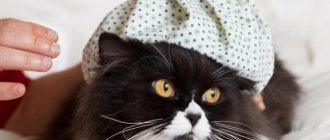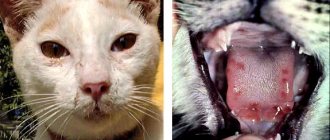Cat diseases are difficult to diagnose independently, as their signs often overlap. Due to late visits to the veterinarian, treatment becomes ineffective, which worsens the chances of a successful recovery. Understanding the basic symptoms that appear when your health worsens and following preventive measures that reduce the likelihood of developing pathologies will help you avoid sad consequences.
How to tell if your cat is not okay
The prognosis for the treatment of cat diseases depends on the symptoms and the time of their detection. Changes in the pet’s usual state are:
1. Behavioral.
If an active and always hungry cat spends the entire day on the couch, avoids communication and refuses his favorite food, sound the alarm. Reverse changes are no less dangerous. Excessive activity and increased appetite, which are not characteristic of an animal, are a sign of a malfunction within the body.
2. Physiological.
This group includes more obvious violations that are understandable not only to the owner, but also to an outsider:
- intestinal disorder (diarrhea, constipation);
- difficulty urinating;
- nausea and vomiting;
- the appearance of redness and peeling on the skin;
- hair loss;
- loss of coordination;
- increase or decrease in normal temperature;
- increased or slow heart rate;
- excessive discharge from the eyes, nose or ears.
Of particular danger is the appearance of blood in stool or vomit. This symptom always accompanies internal injuries and requires urgent assistance from a veterinarian.
How to choose the right veterinary center
When starting such a difficult task as choosing a veterinary center, it is recommended to carefully study the reviews and, if possible, look at the branches on the website. It is very important that the establishment is located, if not in a neighboring house, then at least in the same area as you, otherwise it may turn out, for example, that the cat really needs help, but the doctor is not nearby. It is also very important that the veterinary center has its own pharmacy. This will help you buy medications and start treatment as quickly as possible, but if there is a grooming salon nearby, then such a place will be just perfect for you! It is recommended to pay attention to which doctors work at the veterinary center. You may most likely need help:
- an ordinary veterinarian;
- dentist;
- neurologist;
- nephrologist;
- dermatologist;
- Ultrasound specialist;
- gynecologist;
- cardiologist;
- ratologist.
All our specialists love what they do, which means that veterinary medicine is our element, in which we like to spend most of our time, devoting ourselves to saving our little brothers.
The main advantage of a veterinary service is a unique service - a doctor visiting your home. It is not very popular among our compatriots, since the vast majority consider it a whim for a rich and unnecessary option.
However, in the matter of treating an infection, if you suspect viral diseases of cats have manifested themselves in your pet, such help can be very timely! You shouldn’t skimp on your pet’s health, because he didn’t skimp on his positive energy when communicating and playing with you!
Description of diseases with symptoms and prevention
Cat diseases are classified according to the place of occurrence and causes of infection. Most often they affect the skin, organs of vision and hearing, teeth, genitourinary system, gastrointestinal tract, cardiovascular and musculoskeletal systems. The risk group includes unvaccinated and uncastrated animals. They are especially vulnerable to infectious and oncological pathologies.
Viruses and infections
Infectious diseases in cats are caused by single-celled microorganisms: viruses, bacteria and fungi. The most dangerous are pathologies of viral etiology. They constantly mutate and retain their pathogenic properties for a long time, even in the external environment.
Panleukopenia (distemper)
Panleukopenia is transmitted through direct contact with an infected person and his biological fluids (urine, saliva). It is easily transferred to clothing and shoes, so the only effective method of prevention is vaccination. Lack of vaccination increases the risk of complications and death. When infected, the following are observed:
- fever;
- weakness and apathy;
- loss of appetite;
- foamy yellow or green vomit;
- foul diarrhea;
- the appearance of skin inflammations, gradually filling with purulent contents.
Distemper is especially dangerous in kittens - without urgent treatment, the probability of death tends to one hundred percent.
Calcivirosis
Animals become infected through nutrition (contact with an infected person) or aerogenously (care items, clothing). To protect against calcivirus, mandatory vaccination is recommended for up to a year. Infected people develop:
- fever;
- leakage of serous fluid from the eyes and sinuses;
- profuse drooling;
- swelling and ulcers on the skin.
In kittens, calcivirosis progresses rapidly, so immediately after detecting suspicious symptoms, you need to take the baby to a veterinarian.
Rhinotracheitis
The virus spreads in a similar way to plague and calcivirus. The risk of infection is reduced by complex vaccination at 2-3 months, and then by annual vaccination. When infected it is noted:
- lethargy and loss of appetite;
- increased body temperature;
- runny nose with discharge of serous or purulent fluid;
- cough and shortness of breath;
- ulcer of the cornea and tongue.
In terms of symptoms, rhinotracheitis is similar to chlamydia, but it is not dangerous for people and other pets.
Salmonellosis
The pathogen enters the body along with fish or meat that has not undergone heat treatment. Its symptoms are similar to feline distemper, but are easier to treat. These include:
- lethargy;
- a sharp increase in temperature;
- frequent vomiting and diarrhea interspersed with blood;
- profuse drooling;
- convulsions;
- discharge of pus from the sinuses.
Advanced salmonellosis leads to bronchopneumonia and is especially dangerous for kittens.
Trichophytosis (ringworm)
The risk of fungal infection occurs with low immunity. Ringworm is contagious to all mammals, including humans, and treatment lasts at least 1 month. After the first symptoms of this disease are detected, the cat is diagnosed and treatment begins. You should contact your veterinarian if:
- severe itching;
- peeling and inflammation;
- hair loss;
- pigmentation changes.
For preventive purposes, vaccination is acceptable, but it is less effective than vaccination against panleukopenia. Regular cleaning of the premises, timely administration of anthelmintics, high-quality nutrition and preventive examinations by a veterinarian will help to avoid infection.
Parasitic infections (helminthiasis, flea and tick infestations)
Parasitoses are placed in a separate group. They are accompanied by itching, partial baldness and bowel dysfunction. To protect against parasites, it is recommended to carry out regular antiparasitic treatment and avoid contact with unfamiliar animals.
Skin problems
Skin problems not related to body trauma are caused in two ways: infectious and allergic. Each of them requires specific treatment.
Infestation with scabies mites (otodectosis, demodicosis, sarcoptic mange, notoedrosis)
Parasites are transmitted through direct contact with an infected person or with his personal belongings. An exception is the demodex canis mite, which causes demodicosis. It lives in the body from birth, but becomes pathogenic only with a sharp drop in immunity. If a cat is sick, then soon its entire body will be covered with scabies. When infected, the following appears:
- constant itching;
- excessive hair loss, leading to the formation of bald spots and bald spots;
- inflammation of the lymph nodes;
- nodular rash filled with thick fluid;
- severe pain at the site of redness and suppuration.
Unlike humans, for whom scabies mites are not life-threatening, cats can die. This happens in advanced cases when parasites have penetrated into the internal organs.
Allergy
Most often, pets experience atopic dermatitis (an allergy to pollen and other environmental components) and an allergic reaction to flea bites. Food allergies are also common, especially in albinos or sensitive breeds. This is an individual reaction of the body to certain irritants, so it is difficult to avoid it with preventive measures. Allergy attacks are suppressed with glucocorticoids and antihistamines. They appear:
- itching;
- small rash;
- partial baldness and dandruff formation;
- the appearance of granulomas and ulcers on the body.
The danger of skin diseases in cats is the high probability of secondary infection. Open wounds attract pathogenic microorganisms, so it is important to eliminate them first.
Pathologies of the oral cavity
With insufficient oral hygiene or eating only soft foods, tartar forms on the teeth. Due to the accumulation of plaque, the surface of the tooth is damaged. Bacteria penetrate into it, damaging the enamel and gums. A sick pet develops caries or periodontitis. Older animals have a poor prognosis and often require removal of damaged teeth.
Gum damage is accompanied by:
- low appetite;
- unpleasant odor from the mouth;
- profuse salivation;
- the formation of yellow-brown deposits on the enamel;
- redness and inflammation of the gums.
For preventive purposes, it is recommended to regularly clean your mouth. It is also important to combine dry and wet feeding. Hard pieces of dry food clean the surface of the tooth, and soft food relieves stress on the gums.
Eye and ear diseases
Ophthalmological diseases in cats are very dangerous and can lead to loss of vision. The most common:
- Conjunctivitis
. The main causes of damage to the mucous membrane of the eye are mechanical injuries, chemical poisoning, bacterial infection and allergies.
- Blepharitis
. Damage to the cornea is caused by parasites or internal disorders (problems with hormones, sebaceous glands or autoimmune diseases).
The symptoms of these pathologies are similar and include:
- redness and swelling of the mucous membrane;
- increased lacrimation and swelling of the eyelids;
- difficulty opening eyes.
Regular eye examinations and the use of Diamond Eyes drops, which have an antibacterial effect, will help you avoid unpleasant consequences.
Ear care is also important, which involves weekly cleansing of accumulated plaque. Otherwise, otitis may occur, accompanied by:
- change in behavior (lethargy, anxiety and aggression);
- shaking the head due to itching;
- formation of redness and brown discharge in the ear.
Similar symptoms occur with otodectosis - infection with ear mites. Without timely treatment, hearing loss may occur. The risk group includes kittens and older individuals.
Diseases of the genitourinary system
Urolithiasis in cats occurs due to feeding with low-quality food, as well as low activity and excessive body weight. Its symptoms include:
- difficulty urinating;
- the appearance of blood in the urine;
- severe pain;
- restless behavior and refusal to eat.
In advanced cases, the bladder may rupture, which can be fatal for the pet. A balanced diet, weight control and regular physical activity will help avoid the development of urolithiasis.
Gastrointestinal disorders
Gastrointestinal upset is always accompanied by vomiting, diarrhea or constipation. More pronounced symptoms depend on the specific type of pathology:
- Diabetes
. Accompanied by increased thirst and frequent urination. In a complicated form, it is fraught with coma, which can be stabilized. The disease is typical for cats with a sedentary lifestyle that have not been castrated.
- Gastritis
. Accompanied by the appearance of a white coating on the tongue and an unpleasant odor from the mouth. It often becomes chronic and is associated with poor quality feeding.
For prevention purposes, monitor the amount of food you eat and avoid overeating. Play with your pet regularly and monitor its weight.
Cardiovascular pathologies
Every tenth cat is diagnosed with hypertrophic cardiomyopathy. It is accompanied by rapid heartbeat and fainting. Other symptoms (lethargy, rapid fatigue) are hardly noticeable, so treatment is not always provided in a timely manner. This disease in cats is genetic and cannot be prevented. The only way to avoid complications is to regularly visit the veterinarian. The sooner the problem is diagnosed, the less likely the consequences.
Other cardiac pathologies (for example, heart attack) are very rare in cats.
Oncology
At an early stage, oncology is difficult to diagnose due to vague symptoms. Common diseases include:
- sarcoma;
- carcinoma;
- lymphoma.
The patient's appetite decreases, bowel dysfunction occurs, and body weight decreases sharply. Malignant neoplasms appear on the body: spots, bumps, swellings, ulcers. When palpated, they cause pain and can grow on neighboring tissues.
Unvaccinated and uncastrated animals are more vulnerable to cancer. For prevention purposes, it is recommended to sterilize your pet before the first heat, and neuter the cat before the age of one year.
Musculoskeletal disorders
Problems with the musculoskeletal system reduce activity. In advanced cases, they develop into a chronic form. Most often diagnosed:
- Arthritis
. Occurs due to obesity or injury. Swellings that appear in the joint area are accompanied by pain when palpated.
- Arthrosis
. Develops with excessive physical exertion and low amounts of phosphorus and calcium. Leads to lameness, crunching in the joints and their deformation.
Both arthritis and arthrosis have similar symptoms. Only a veterinarian can determine the type of violation - after diagnosis, treatment will be prescribed and the basics of caring for a sick animal will be prescribed.
To prevent possible complications, keep your diet balanced. When feeding naturally, be sure to add vitamins to the food, approved by your veterinarian.
Feline infectious peritonitis
An extremely dangerous and almost always fatal viral infection of domestic and some wild animals. Thus, the disease affects pumas, lynxes, lions and cheetahs. It is interesting that in nature there are two types of this virus, and it is not always possible to distinguish them by “external” signs even in laboratory conditions (only in animals they act in radically opposite ways). One of them, although it develops in the body of predisposed animals, causes only “mild” clinical signs, and more often there are no manifestations of the disease at all (FECV). The virus that causes “classical” infectious peritonitis is designated FIPV. Why are these pathogens so similar? In fact, they are the same virus. It has been shown repeatedly that FECV can spontaneously mutate into FIPV. Why does this happen? The question is interesting, but there is no answer to it yet. No one has yet described cases of reverse “transformation”.
And that is why another problem arises. It is still unknown what the actual prevalence of the virus in nature is. At one time, research by Italian, Chinese and Russian veterinarians proved that the FECV coverage rate can reach 35-40% (at home), approaching 93% if we talk about nurseries and animal shelters. Today, experts are inclined to believe that at least 5% of sudden deaths of cats occur due to spontaneous mutations of the virus and its transition to a pathogenic state.
Clinical picture
"Dry" or non-expansive form. Occurs in approximately ¼ of affected cats. “Clinic” is growing slowly. The animal's appetite gradually worsens, it becomes lethargic, and the quality of its coat decreases. Neurological seizures occur in 10-25% of cases. Paralysis, disorientation, trembling and convulsions, involuntary release of urine and feces are possible. Sometimes the liver and kidneys fail. In some cases, the only sign indicating the presence of infection is eye lesions (conjunctivitis and keratitis). Note that eye diseases are a classic symptom of many viral infections.
"Wet" or expansive form. It flows much more severely, it turns on. Intermittent fever often develops. In more than 70% of cases, progressive anemia develops, and digestive problems also appear (in the form of intermittent cases of diarrhea and constipation). To make matters worse, infectious peritonitis in the expansive form almost always develops ascites (edema of the abdominal cavity), making the cat look like a pear. In about 27% of cases, hydrops of the chest cavity also develops (sometimes even simultaneously with ascites), which causes breathing problems. Unfortunately, about 83% of cats with this form of the disease die within two weeks of the first signs appearing.
What to do?
As in the previous case , there is no specific treatment. Therapy is symptomatic; human interferon is also used. Ascites is combated by promptly pumping out fluid from the abdominal cavity through a catheter, and simultaneously prescribing medications that support liver function. Anti-inflammatory corticosteroids and loading doses of antibiotics (to prevent secondary infections) are often prescribed.
As a rule, it is still not possible to completely destroy the virus, but it can be suppressed. Subsequently, “formally” cured animals must be examined by a veterinarian at least once a quarter.
Diseases common in kittens
For kittens, pathologies accompanied by vomiting and diarrhea are especially dangerous. The likelihood of death with rapid dehydration is maximum. Babies can catch the infection both from outside and from their mother. Therefore, it is especially important to protect very young kittens that have not yet been vaccinated.
Most often, kittens are diagnosed with the following diseases:
- Otodectosis
. If intense itching, redness and brown-black discharge from the ears appear, not only the infected person, but also other pets are treated.
- Flea infestations
. Severe infection can lead to anemia. Fleas can also be carriers of mycoplasmas and infect the baby with mycoplasmosis.
- Panleukopenia
. When infected, a fulminant form is often observed. The baby fades away within a day.
- Upper respiratory tract infections (calcivirosis, rhinotracheitis)
. Accompanied by a runny nose, sneezing and lacrimation. It spreads quickly from one animal to another and requires mandatory treatment.
- Helminthiasis
. Intestinal parasites can be transmitted through breast milk or through contact with outdoor shoes. Worm the animals before mating and keep the kittens in an enclosure until the first vaccination and anthelmintic treatment.
For the health of your fur baby, vaccinate it immediately after separation from its mother. This will help protect it from most dangerous infections.
Viral infections
Most dangerous diseases are caused by viruses. The following diseases are common:
- Panleukopenia (feline distemper). It has a high mortality rate. The survivors become virus carriers. Young animals and old animals are sick. The virus is transmitted by blood-sucking arthropods. Symptoms:
- Vomit.
- Yellow-green diarrhea with blood.
- Herpes. Transmitted through the placenta. Symptoms:
- Keratitis.
- Purulent conjunctivitis.
- Yellow-green color of feces.
- Stillbirth.
- Rabies. The most dangerous zooanthroponosis. The pathogen is found in the saliva of sick animals. Infection occurs through a bite. Symptoms - nervous phenomena:
- Salivation.
- Aggression.
- Appetite is perverted.
- Photophobia.
- Rabies.
- Paralysis.
Rabies in a cat
- Aueszky's disease.
Cats that come into contact with rodents get sick. The virus is transmitted to productive animals, through whose meat humans become infected. Symptoms - nervous phenomena:
- Skin itching.
- Loud meow.
- Salivation.
- Vomit.
- Photophobia.
- Calcivirosis. The respiratory organs suffer. They become infected through contact with sick cats. Symptoms:
- Rhinotracheitis.
- Stomatitis.
- Vision pathologies.
Calcivirosis
- Viral rhinotracheitis. The organs of vision and breathing suffer. Infection is contact. Symptoms:
- Rhinitis.
- Conjunctivitis.
- Cough.
- Fever.
Rhinotracheitis
- Flu. Combination of calcivirosis and rhinotracheitis viruses.
- Coronavirus peritonitis. Nursery disease. Infection is contact. Symptoms:
- Fever.
- Vomit.
- Dropsy.
- Leukemia. Blood carcinoma. Infection is contact. Symptoms:
- Fever.
- Dermatitis.
- Anemia.
- The wounds are healing slowly.
- Immunodeficiency. An analogue of the human HIV virus. Infection is contact. Symptoms:
- Lack of appetite
- Anemia.
- Diarrhea.
- Nipple swelling.
Age-related diseases of cats
In older cats, most diseases are associated with a gradual decline in immunity. Due to disruptions in the immune system, the following develops:
- diabetes;
- renal and liver failure;
- hypertrophic cardiomyopathy;
- thyroid diseases;
- arthritis;
- inflammation of the gums
There are other ailments that are dangerous for old cats, but the ones listed are the most common. If the pet has not given birth and has not been sterilized, then there is a high risk of developing malignant tumors on the mammary glands or pyometra (uterine abscess). Their removal often requires surgery performed under general anesthesia. It is difficult to tolerate in old age, so be sure to sterilize non-breeding animals immediately after puberty.
Pay special attention to nutrition - the veterinarian will tell you which diet is suitable for an older pet. Ideally, your cat should be examined by a veterinarian every six months after reaching 10 years of age. This will include an examination and blood sampling.










